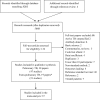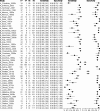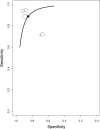Systematic review and meta-analysis of antigen detection tests for the diagnosis of tuberculosis
- PMID: 21832100
- PMCID: PMC3187027
- DOI: 10.1128/CVI.05205-11
Systematic review and meta-analysis of antigen detection tests for the diagnosis of tuberculosis
Abstract
Tests that detect Mycobacterium tuberculosis antigens in clinical specimens could provide rapid direct evidence of active disease. We performed a systematic review to assess the diagnostic accuracy of antigen detection tests for active tuberculosis (TB) according to standard methods and summarized test performance using bivariate random effects meta-analysis. Overall, study quality was a concern. For pulmonary TB (47 studies, 5,036 participants), sensitivity estimates ranged from 2% to 100% and specificity from 33% to 100%. Lipoarabinomannan (LAM) was the antigen most frequently targeted (23 studies, 49%). The pooled sensitivity of urine LAM was higher in HIV-infected than HIV-uninfected individuals (47%; 95% confidence interval [CI], 26 to 68% versus 14%; 95% CI, 4 to 38%); pooled specificity estimates were similar: 96%; 95% CI, 81 to 100% and 97%; 95% CI, 86 to 100%, respectively. For extrapulmonary TB (21 studies, 1,616 participants), sensitivity estimates ranged from 0% to 100% and specificity estimates from 62% to 100%. Five studies targeting LAM, ESAT-6, Ag85 complex, and the 65-kDa antigen in cerebrospinal fluid, when pooled, yielded the highest sensitivity (87%; 95% CI, 61 to 98%), but low specificity (84%; 95% CI, 60 to 95%). Because of the limited number of studies targeting any specific antigen other than LAM, we could not draw firm conclusions about the overall clinical usefulness of these tests. Further studies are warranted to determine the value of LAM detection for TB meningitis in high-HIV-prevalence settings. Considering that antigen detection tests could be translated into rapid point-of-care tests, research to improve their performance is urgently needed.
Figures






References
-
- al-Orainey I. O., Gad el Rab M. O., al-Hajjaj M. S., Saeed E. S. 1992. Detection of mycobacterial antigens in sputum by an enzyme immunoassay. Eur. J. Clin. Microbiol. Infect. Dis. 11:58–61 - PubMed
-
- Alvarez-Uria G., et al. 2009. Non-tuberculous mycobacteria in the sputum of HIV-infected patients: infection or colonization? Int. J. STD AIDS 20:193–195 - PubMed
-
- Anie Y., et al. 2007. Diagnostic approaches in patients with tuberculous pleural effusion. Diagn. Microbiol. Infect. Dis. 59:389–394 - PubMed
-
- Araj G. F., Fahmawi B. H., Chugh T. D., Abu-Salim M. 1993. Improved detection of mycobacterial antigens in clinical specimens by combined enzyme-linked immunosorbent assay. Diagn. Microbiol. Infect. Dis. 17:119–127 - PubMed
Publication types
MeSH terms
Substances
LinkOut - more resources
Full Text Sources
Other Literature Sources
Medical

